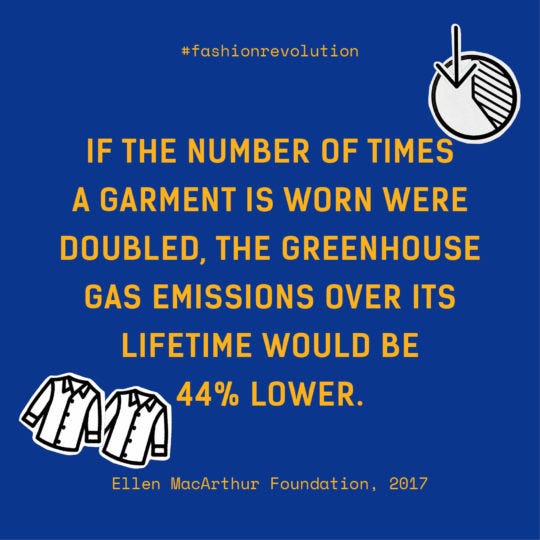Welcome to the Green Fix. Now let's get something done.
An introduction, explanation, and a chat about slow fashion with Tena Lavrenčić
I read the news headlines with my mouse ready to click off the page. I never do - I feel too guilty. I should know what atrocities are happening around the world.
You want to make a difference, I mutter to myself as I scroll through an Instagram feed of neverending ‘unrecognised crises.’ Don’t look away.
But I wasn’t making a difference. Reading about icecaps melting and then staring at my own sad reflection in the kettle as I stress-boil the fifth cup of tea rather than work doesn’t do anything. What I was craving was solutions.
Reusable bags and mugs and outrage are great, sure, but they only get you so far. If you’ve ever felt overwhelmed by the continuous stream of advice about what the most effective actions are, or felt like online eco guides swing widely between congratulating you for turning down a plastic straw, and expecting you to develop an expert-level knowledge of climate justice before you can do anything (what do you mean you’re not sure which non-dairy milk has the lowest carbon footprint?), you’re not alone.
I’m broke, busy and bombarded with information. And it’s not helping the planet much.
And so the idea for The Green Fix was born.
This newsletter rounds up concise advice and resources for people who want to inform themselves and do more about the climate crisis without the time to become world experts. Along the way, we’ll as unpack some common environmental concepts. You don’t need money, time or expertise you just need to care.
The Green Fix is collaborative: that means, I want to talk about what you want to know! This relies on people sending in their questions, suggestions, and resources they’ve found useful. Shape the newsletter by filling in this feedback survey.
If you want to get in touch directly, email me at casshebron@gmail.com.
What’s Going On?
Six young people from Portugal have taken 33 countries to court for the climate impact of national emissions, and the effect that corporate activity has around the world.
Stay updated and support their case on their website Youth4ClimateJustice.Members of global climate protest organisation Extinction Rebellion delayed the distribution of several Murdoch-owned UK newspapers after blocking access to key printing presses, arguing that the papers fail to reflect the urgency of the climate crisis.
Useful context: Who owns the media in the UK and why does it matter?A new scientific study suggests that the amount of carbon absorbed by oceans has been significantly underestimated.
Useful context: The role of oceans in climate change.The first ever mainly-virtual UN General Assembly, a meeting of world leaders, begins on the 15th September and it plans to put sustainable development at the heart of its discussions.
Useful context: What is the point of a UN General Assembly?A report finds that over 60% of European cities that have committed to certain climate targets are on track to meet their goals.
Context: How does a [European] city make a climate commitment?
Focus On… Slow Fashion
Freelance sustainable fashion writer Tena Lavrenčić on what slow fashion is, and why it’s about more than just what you wear.
We are pushing this planet far beyond its limits. Earth Overshoot Day has been moving earlier and earlier over the years. And yes, although the date this year moved forward a few weeks, we still have to face the truth: we are overconsuming our planet.
One of the leading areas we overconsume is through our shopping. The fashion industry produces so much that the equivalent of 1 garbage truck of garments gets disposed of every second. We simply can’t use the amount we produce. It’s a hugely polluting industry, and it’s largely built on a system of exploitation and unfair labour.
But why is fashion so crucial to the climate crisis? Aren’t other industries contributing equally - if not more - to climate change, social inequality, and depletion of natural resources?
Fashion is interconnected with many major industries: agriculture, energy, technology, education, media, to name a few. As Orsola de Castro, the co-founder of Fashion Revolution, said: fashion affects 100% of the population. Everybody who wears clothes is a part of the fashion system. This means that everybody can contribute to the change. The question is: what change do we want?
Slow fashion is a movement that rebels against the dominant, fast fashion model. It means stepping away from the constant urge to buy more, the trends, and changing the way we think about the clothes we wear. Many small brands have embraced it as a business model, making their clothes in smaller batches and designing them to last, instead of being worn only a few times.
Slowing down fashion consumption has an immense effect on the industry and the planet. But I was surprised how it can also profoundly change those who practice it. Slow fashion changed who I am.
Consciously stepping away from the fashion trends and big stores (where I never felt like I belong anyway) made room for me to really think about my style. I started focusing on what I like to wear and what makes me feel good, instead of trying to squeeze my body into whatever is currently a “must-have”. I stopped trying to wear what I thought I should and I realised that I can wear things I like all the time. You can imagine how my confidence grew.
Buying second-hand or from small brands also made me appreciate the clothes I own. I no longer think of them as disposable items, but as valuable objects that help me externalise my values, taste, creativity, and identity. You can’t put a price on that.
Now, slowing down fashion does not stop at shopping differently. As I wrote in a recent article, we can influence fashion in many ways: in advocacy, education, art, business, and more.
I also support sustainable and ethical fashion brands through my content writing business, Thinking Threads. I invite you to find the ways in your life where you can create change too. Trust me, we need everybody on board.
Follow Tena on Instagram @thinking.threads.
So Now What Do I Do?
LEARN MORE
Sign up for the free online course on Fashion and the Sustainable Development Goals, by sustainable fashion campaign organisation Fashion Revolution.
Calculate your individual fashion footprint using this online calculator by ThredUp.
Sign up to this specialist ethical fashion newsletter.
TRY SOMETHING NEW
Use the Good On You app to see how ethical your favourite fashion brands are & find sustainable brands to support.
Read: 10 easy ways to make your wardrobe a bit more sustainable.
Sign up to Secondhand September, a free campaign run by international anti-poverty charity Oxfam to encourage people to avoid buying any new clothes for a month. Share your pledge on social media to spread the word!
CHANGE THE SYSTEM
Check out ethical fashion advocacy organisation Fashion Revolution who have created a page on how citizens can support their work to push for laws to make fashion production greener & fairer.
Slow Fashion Season is a campaign running until the 21st September, but there’s never a bad time to get involved. Pledge to join the movement, and follow and share @slowfashionseason on Instagram.
Follow the UN Fashion Alliance on social media to keep up-to-date and support action for ethical fashion happening at the global level.
IS THAT IT?
No. As much as I wish my writing skills were so good that I can summarise sustainable fashion in a few bullet points, there’s way more than I can include in one email.
If you think a crucial resource is missing or there’s more you want to know, let me know by filling in this feedback form.
Stay in the loop
Follow my Instagram @coffee_and_casstaways. Please say hi, it makes me feel like I had a good reason to scroll the app for a seventh time this morning.






